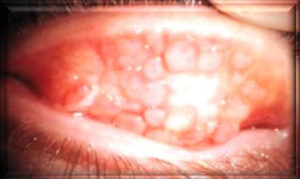
Conjunctivitis

The conjunctiva is the membrane that lines the anterior part of the eyeball, continuing to the inner surface of the eyelids. Inflammation of the conjunctiva is called conjunctivitis. There are two types infectious and non-infectious.
Infectious Conjunctivitis
They can be caused by germs, viruses or chlamydia. Bacterial conjunctivitis is characterized by:
•Acute onset with redness of the eye and sticky discharge (eye gum)
•Mild or moderate itching may also be present
•Burning or foreign body sensation.
•Vision is not greatly affected. A significant decrease in vision may mask another more serious cause, or corneal involvement.
In most cases of bacterial conjunctivitis, a broad-spectrum antibiotic eye drop is usually prescribed.
Gonococcal conjunctival infection is an acute and very serious condition because the gonococcus can penetrate even the intact (uninjured) corneal epithelium causing significant damage if not treated with specific antibiotic therapy.
Viral conjunctivitis have some characteristics that differentiate them from microbial ones. Here too there is redness of the eye, but the discharge is more watery than purulent. A frequent finding is the swelling of the preoral lymph nodes, as well as the swelling of the eyelids, which is sometimes so intense as to cause their convergence.
They often occur in the course of childhood viral infections and require special attention due to their high transmissibility. Special care must be taken for frequent hand washing, not using shared towels, pillows, etc.
Like most viruses, viral conjunctivitis runs its course and does not require specific treatment. Exceptions are cases of conjunctivitis caused by herpes viruses (which are usually accompanied by a vesicular rash on the eyelids), where special antiviral agents are used.
Of the chlamydial conjunctivitis, the most well-known is trachoma, which is also the 3rd most common cause of blindness worldwide after cataracts and glaucoma. It is a chronic conjunctivitis, which usually affects countries with insufficient sanitary conditions. Treatment is with appropriate antibiotics.
Non-Infectious Conjunctivitis
They include acute and chronic allergic conjunctivitis and some scarring and vesicular lesions of the conjunctiva.
Allergy is the overreaction of the body to some apparently “harmless” substance in the environment. The most common allergens are pollen, mold, animal saliva, various chemicals, as well as certain foods and medications.
Acute allergic conjunctivitis is characterized by a sudden onset, with itching, eyelid swelling and conjunctival swelling. In order to cause the allergic reaction, contact with the respective allergen must precede. Thus, the patient must know the substances that affect him in order to avoid them, while the use of artificial tear drops or washing with water is also recommended to remove the allergen, if he has already been exposed to it.
Both for the prevention and relief of acute allergic conjunctivitis, there are several eye drops (vasoconstrictors, antihistamines, etc.)
 Chronic allergic conjunctivitis has several forms, such as vernal and atopic keratoconjunctivitis.
Chronic allergic conjunctivitis has several forms, such as vernal and atopic keratoconjunctivitis.
Spring allergic keratoconjunctivitis affects children more often, and usually boys. It is more pronounced in dry and hot climates, especially in the summer months. Symptoms involve both eyes and include severe itching, redness, burning, foreign body sensation, tearing, thick filamentous discharge and photophobia.
Patients with spring allergic conjunctivitis typically have a positive personal and family history of seasonal allergies, atopic dermatitis, and asthma. After a few years of active disease, the majority of patients experience spontaneous recovery.
The atopic form usually affects older people with a positive personal and family history of cutaneous atopy or asthma. This is a potentially serious disease that can lead to blindness.
A large number of eye conditions coexist with atopic allergic conjunctivitis. These are herpes simplex keratitis, anterior and posterior subcapsular cataracts, and keratoconus.
Treatment of chronic allergic conjunctivitis is similar to that of seasonal allergic conjunctivitis, although topical steroids are more commonly used.
